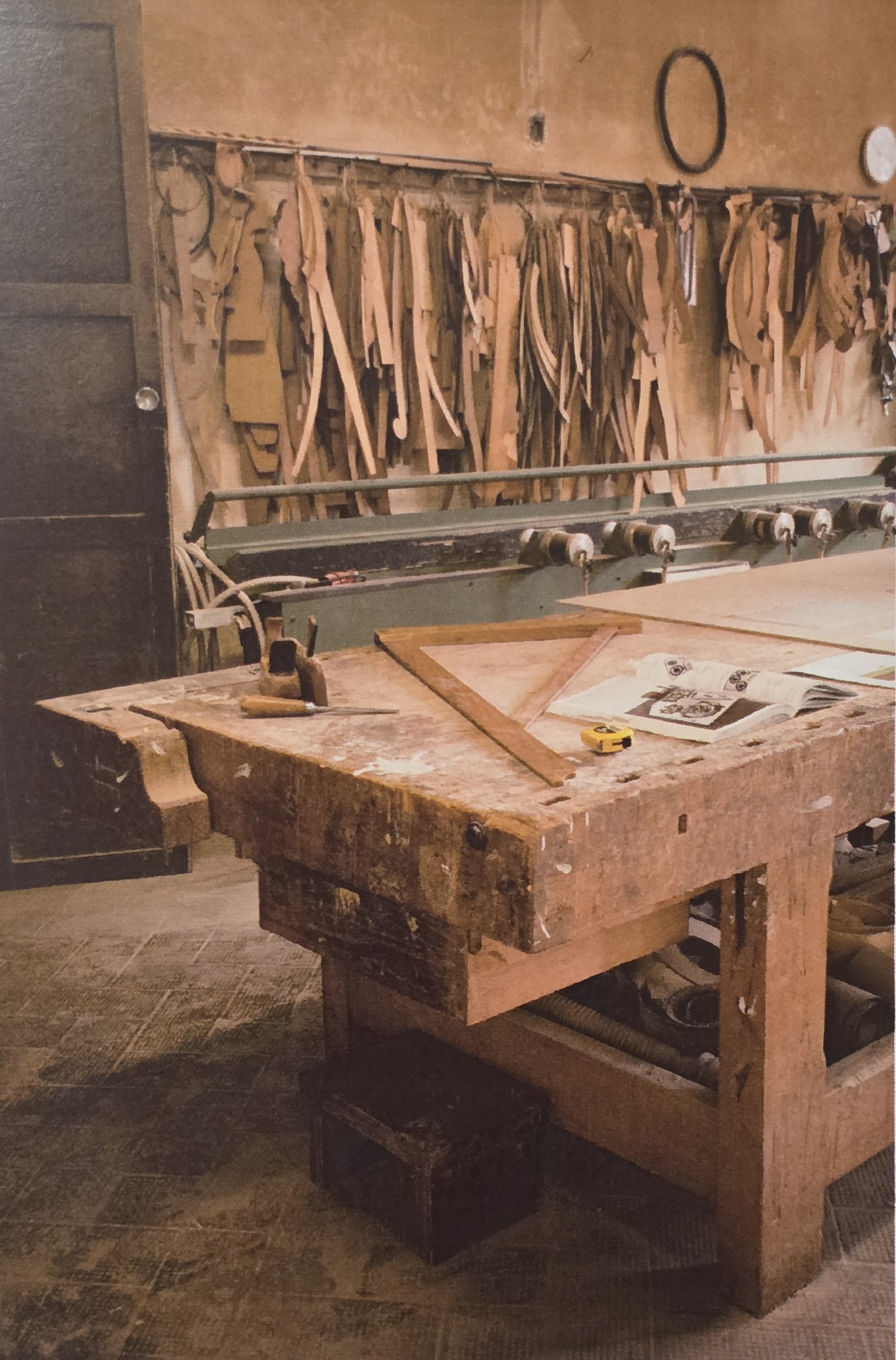
Table inside a Bötega
Photograph author: Sebastiano Erras.
The exhibition hall will display certificates, diplomas and documentation of the productive activities, schools, events and personalities that characterised Lissone until 1970.

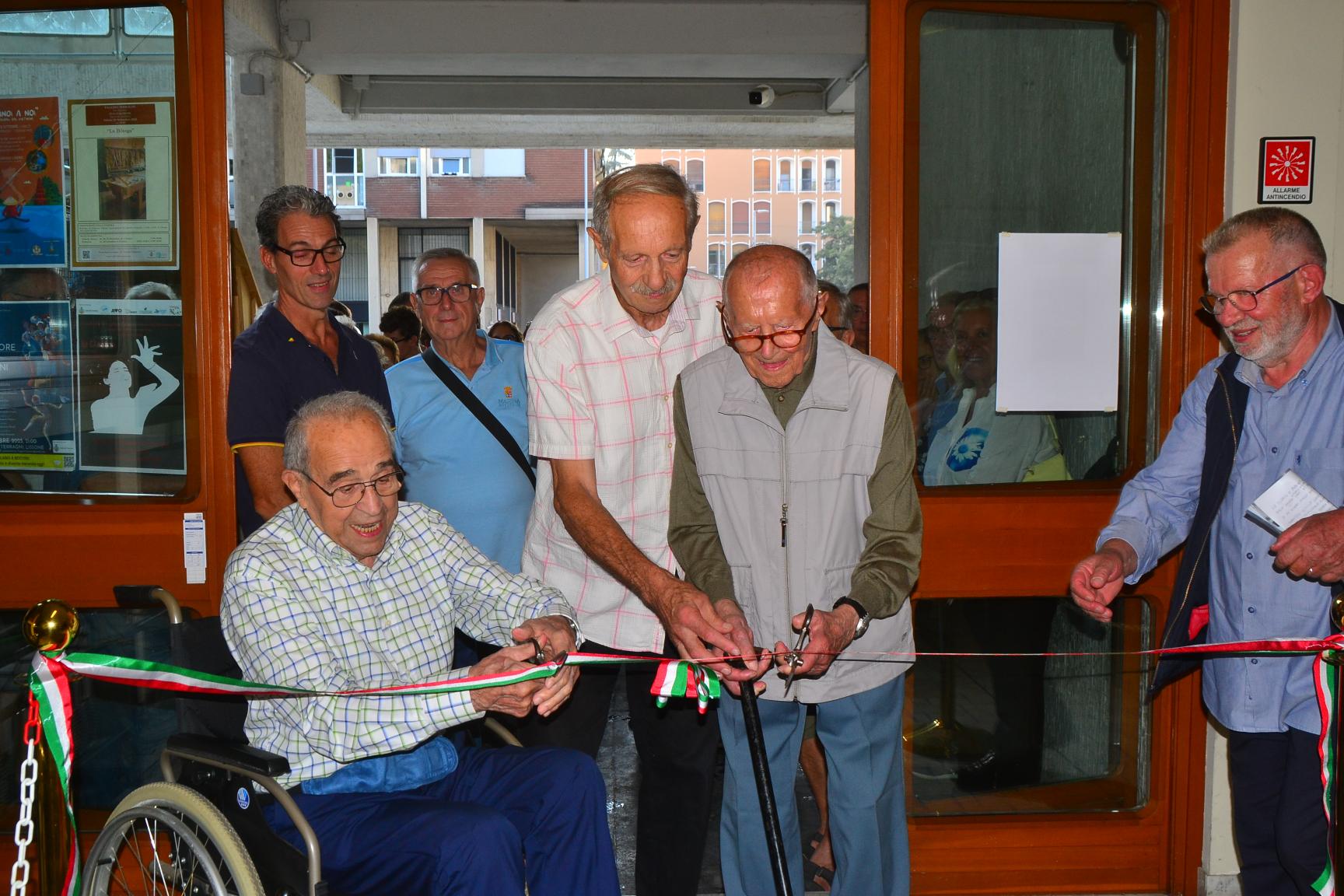
Photographs by Gianni Radaelli of Lissone
Testimonies of the vitality of a town that, despite being close to the large cities of Monza and Milan, was able to be in the spotlight, not only of local, provincial and regional mass media, but especially of national, European and intercontinental ones.

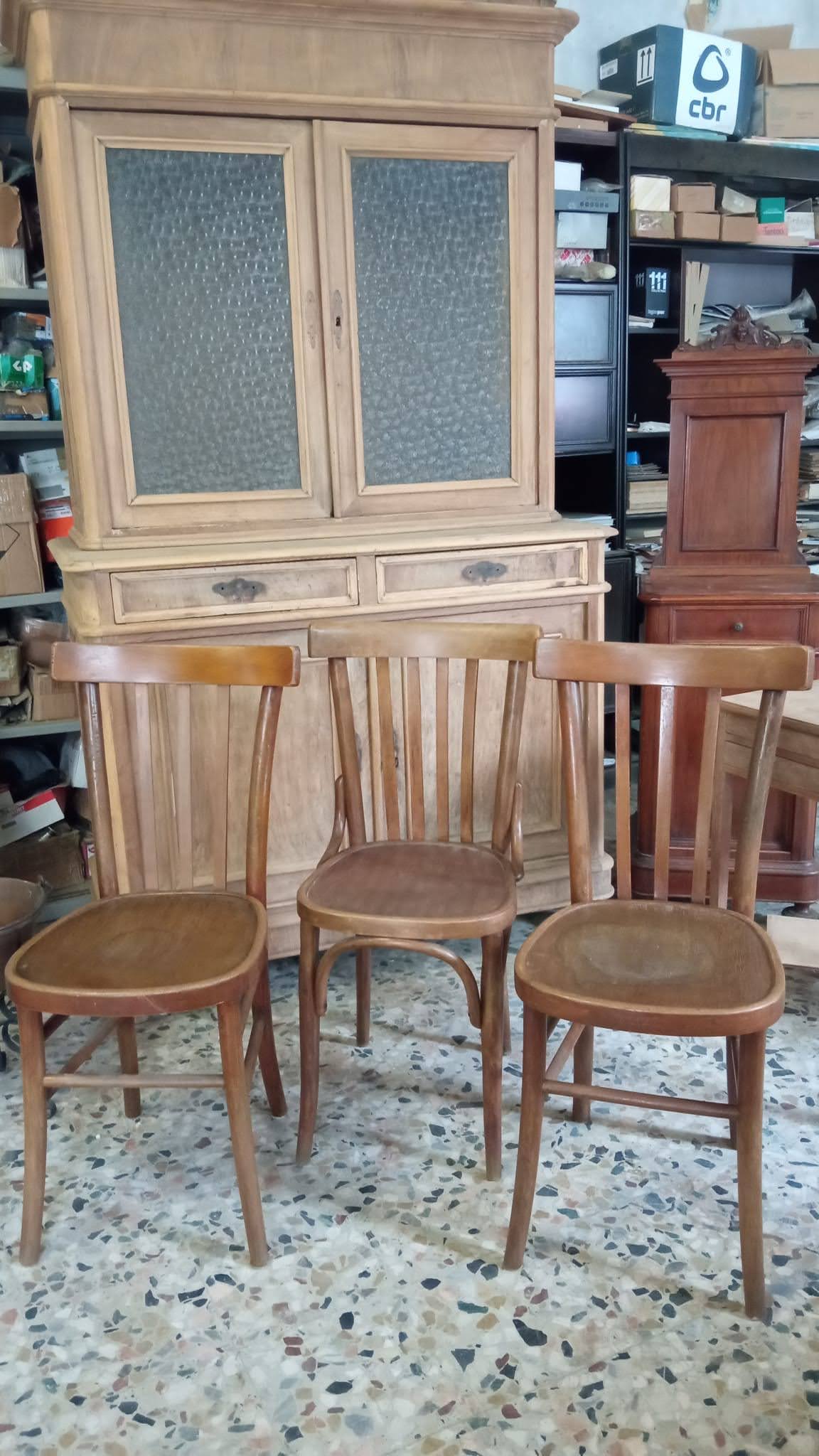
Luterma chairs with walnut sideboard by Dassi Ignazio e C. company. Luterma is among the largest European sawmills with production of tables and seating, in 1907 it partnered with Carlo De Capitani. From their collaboration, plywood was born which would be used in furniture production. In the following decades it would revolutionise technology in furniture construction.
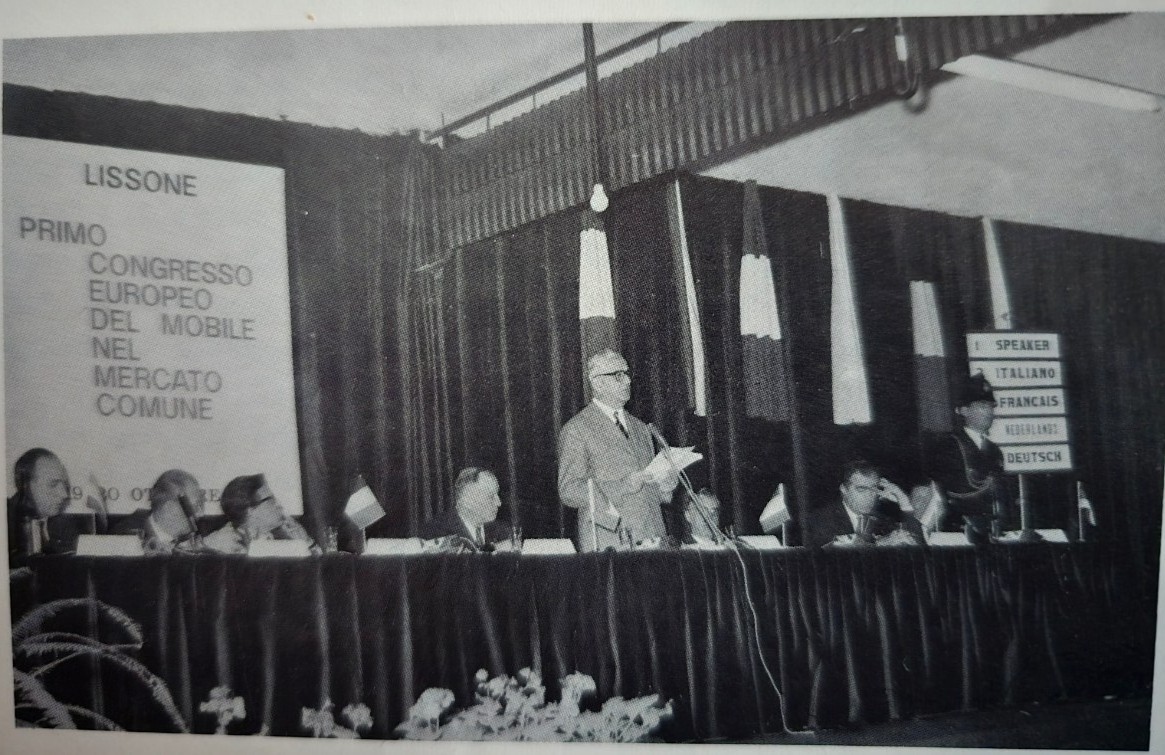
First European Congress of Furniture in the Common Market, Lissone
Coming to light are not only the usual names of large companies, but those who with their skills and dedication to their work formed the fundamental basis of Lissone furniture long before "made in Italy".
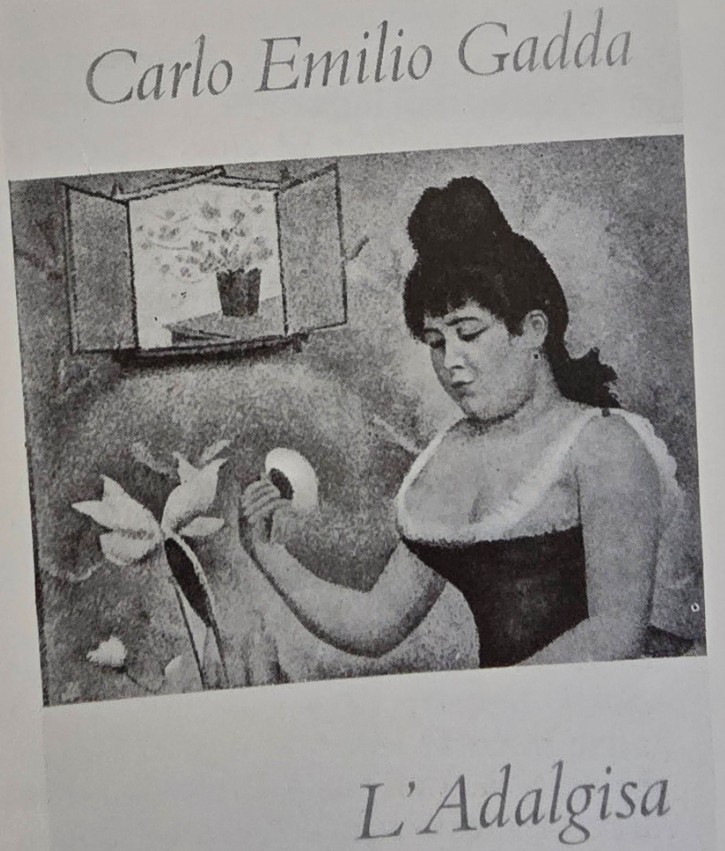
Adalgisa del Gadda marries the mayor who brings as dowry the "Lissone room", desire of all the girls of the time who marry
What is exhibited, accompanied by simple and brief comments, whilst being aware that it is only a small documentation, considering that in 1955 there were more than 2000 craft businesses in the furniture and furnishing sector operating in Lissone, can help the visitor imagine the vitality that characterised Lissone for several centuries and allowed it to be a protagonist in the global furniture market.
A reality that today may seem like a dream and that some people think is boastful. The beginning can be traced back four centuries before 1571 with the suppression of the Order of the Humiliati by Pope Pius V and the removal of the parish priest. As the new parish priest of Lissone, Cardinal Carlo Borromeo sends Don Giovanni Battista Confalonieri.
Even before taking official office on 7th March 1570, on 2nd February 1570 he began keeping parish registers of births, deaths and marriages and from that date there is certain data from the registry office.
Don Confalonieri dedicates his work not only to religion, but to the education of the population, especially the less affluent. Educating a population mostly of illiterate and semi-illiterate people, making them aware of their abilities and their rights from those years. The church becomes a fundamental reference for the population a decade after his death (1599) and therefore events occur that highlight the maturity and certainties acquired by the working world of Lissone.
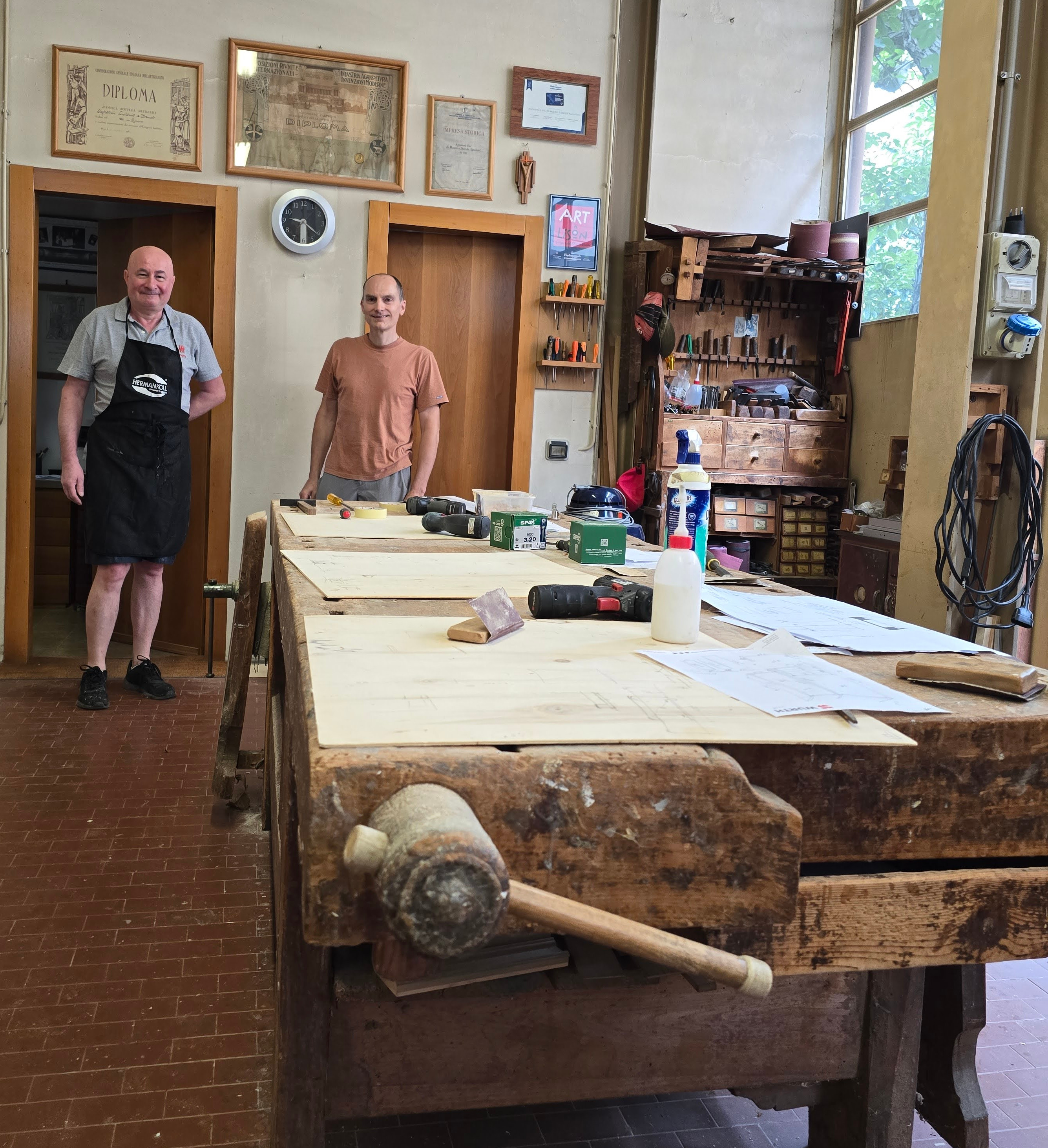
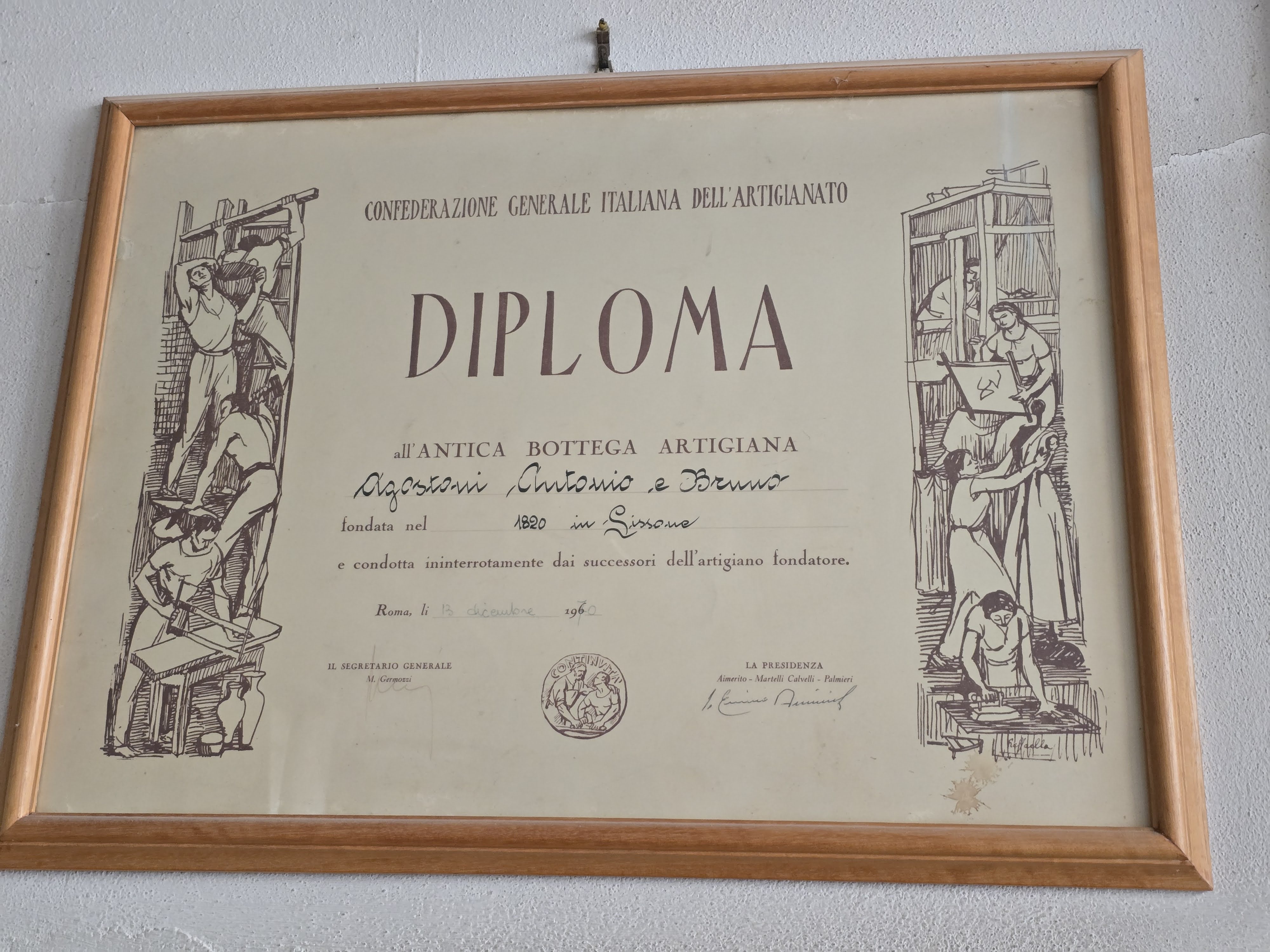
Agostoni Company. The Bötega with the most years of activity, currently run by cousins
Mauro and Davide

Plate on wool processing, from the Encyclopédie by Diderot and d'Alembert, Paris 1751-1772.

Photograph author: Sebastiano Erras.
Wool cloth processing begins in 1300 with some looms, given to some families of their brotherhood of Lissone by the friars of the Humiliati order.
The ability demonstrated by these families in processing induces the friars to increase the number of looms provided, involving other families.
In 1570 the order of friars was excommunicated.
At the beginning of the same year the parish priest of Lissone was removed. In his place Giovanni Battista Confalonieri (1570-1599) was appointed parish priest, even before his official entry as parish priest (7th March 1570).
On 2nd February 1570 he began keeping parish registers of births, deaths and marriages (from that day there is certain data from the Lissone registry office).
His activity was not limited to spreading Christian teachings, but he devoted himself to educating the population with particular attention to the less affluent. The clergy became the most important reference for the social fabric of Lissone.
The dissolution of the Humiliati order brought no damage to the activity of wool cloth processing. The number of looms operating in Lissone is significant, as certified by the census of 14th May 1613 which counted 110.
Comparing this data with that recorded in Muggiò (13), Vedano (11) and Nova Milanese (6), highlights the importance of Lissone in the sector's commerce of that time.
In an activity where water is an important and essential element, Lissone, whilst not being crossed by any watercourse, stands out for the ability and ingenuity of its inhabitants in making the most of the water from existing wells.
The importance of Lissone is highlighted in the same year (1613), when producers from Milan requested and obtained the application of an additional tax on the Lissone product that was marketed in the Milan market. The producers of Lissone made a radical decision against a measure that imposed an additional tax on them, completely stopping their production.
The sector operators in Milan, seeing an important part of their trade vanish, intervened with a petition to President Arresi to have it removed. The latter, with his competence and wisdom, realising the damage that the Milan market was suffering without the Lissone product, immediately removed the tax and urged the resumption of production, promising that as long as he lived, taxes would never again be placed on the Lissone product.
The wood sector activity in the Middle Ages and at the beginning of the Modern Era in Brianza is relegated only to the needs within the family sphere. All members of individual families are employed in agricultural work.
In Lissone a minority part in wool processing constitutes an exception, because there are political situations and laws that make it almost impossible for the population to undertake any other possibility.
Everything changes after 1707, when Spanish domination ends and in their place, the Austrians take over governing the Lombardy-Venetian kingdom. Immediately, with their culture, they also introduce their tax regulations, with the elimination of servile burdens and excessive taxes, regularising a cumbersome and depressing situation for the population.
In the last quarter of the 19th century a new era begins for Lissone, when Empress Maria Teresa of Austria commissioned architect Giuseppe Piermarini to build the Villa Reale di Monza (1777-1780) a short distance from its border, for the summer residence of Archduke Ferdinand of Austria.
For the construction of the Villa Reale, much of the necessary workforce was recruited from the inhabitants of Lissone, who whilst working grasped the basic concepts for woodworking, making the most of their ability to learn and exploit the new opportunities demonstrated over the centuries, opening individual activities in the sector in Lissone that would then be useful in the renovation of the Parish Church (1794-1800).
Opportunity expanded with the successor of the Empress who died in 1780, Joseph II, who in the same year decreed the abolition of corporations and among these that of the "woodworkers", favouring the development of craftsmanship.
In 1800 Lissone becomes a centre of certain relevance in the wood sector, as certified by the 1803 reports of Melchiorre Gioia "Economic discussion of the Olona department". Regarding the wood sector he writes: "our wood manufacture, more than in other parts of Italy, combines the exactness of proportions, the elegance of forms, the lightness of masses and the naturalness of figures" and reports Lissone "as one of the points of the department where major traces of commerce are found" and of Zaninelli who reports "from the report of the chancellor of Celso of the thirteenth district to the prefect of Olona": in Lissone 44 families practice the art of carpentry, 68 people in manufactures use only carpentry tools.
In the following decades there are numerous families that see one or two of their members dedicate their time to carpentry work and thus the furniture-making Lissone is born.
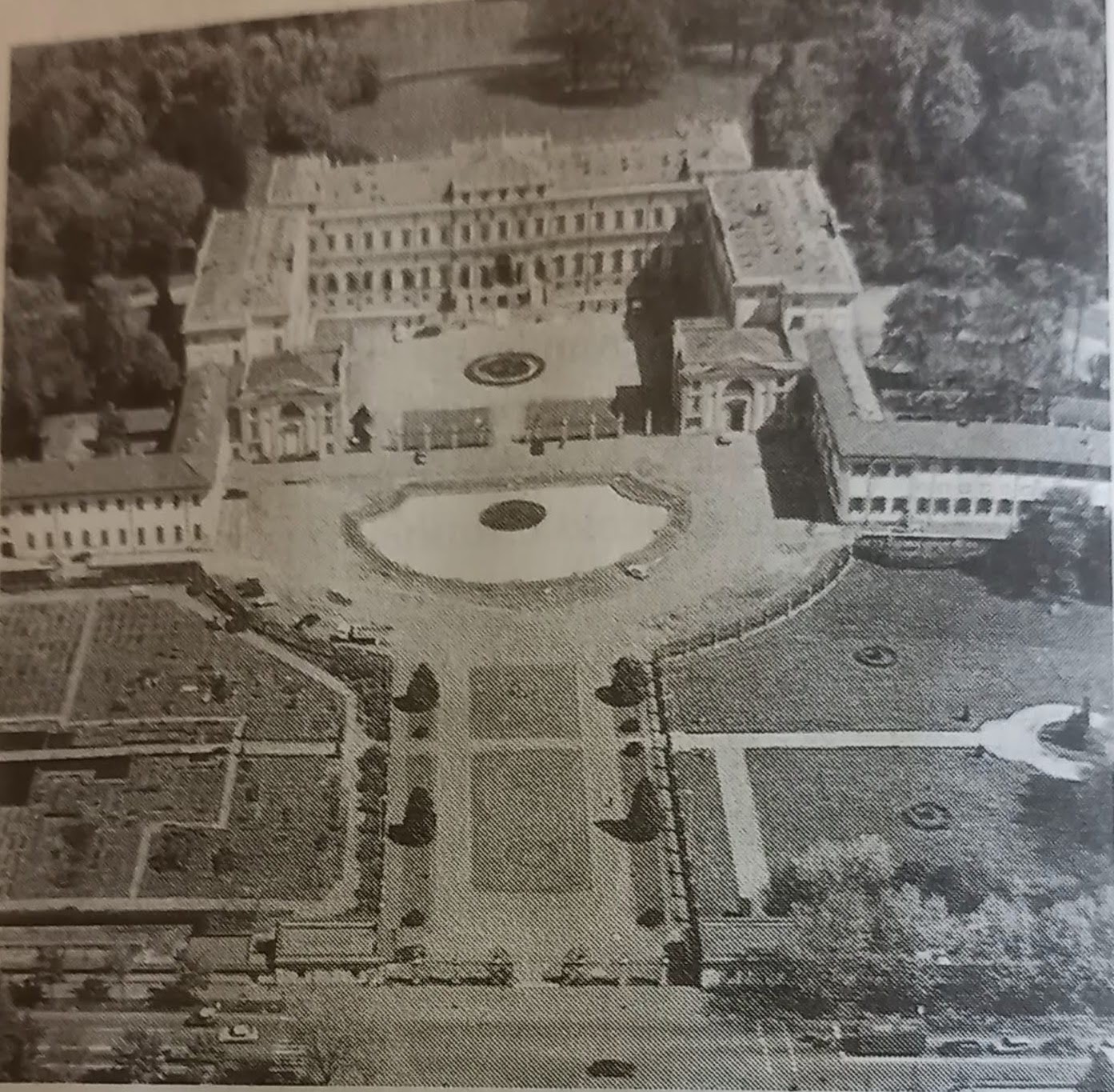
Villa Reale di Monza
Ignazio Cantù in 1837 wrote the first tourist guide to Brianza, in which he describes the castles, churches and Romanesque basilicas and the sumptuous villas set in the characteristic panorama of Brianza. On the last page, after illustrating the villa Traversi formerly Cusani, before passing through Muggiò - where there is the autumn villa of the Barnabites of Monza - and ending the journey in Monza where it started, he writes: "Heading towards Monza, we will need to leave the main road if we want to go to Lissone, a large and populated union of houses of very decent appearance, and full of peasant tumult that makes a nice contrast with the indolence of so many villages of lower Lombardy".
These are words that come out of the context of the other pages of the guide and suggest that Cantù invites visitors to pass through Lissone, where they will immediately find in the inhabitants their industriousness and the dynamism that is intrinsic in the population living in Brianza; especially not mentioning a Lissone that sees continuous evolution, his guide seems incomplete to him.

Guide to the mountains of Brianza and the surrounding lands. Ignazio Cantù - Milano 1837
On 7th December 1849 the Monza-Como railway line was inaugurated, which stops at Camerlata, the first station after Monza and Desio, with tourist appeal of Villa Traversi formerly Cusani. Completion to the shore of Lake Como took place in 1875. Lissone, which increasingly expands its activities, applies to have its own station with goods yard. The proximity to the stations of Monza and Desio seems an insurmountable limit, given that on the whole route there are four stations at a proper distance from each other.
In 1878 the evening school of drawing and cutting was created. Lissone's insistence on having its own station is constant, accompanied by data on railway traffic relevant to its territory which is constantly increasing, finally with a project and a sum for the construction at no cost.
In 1881 the request was finally accepted, and on 6th July 1881 the administration of the railways of Upper Italy informed the municipality, setting as a condition that work would only begin when the offered sum was received. On 10th July, in a meeting specially convened by the municipality with entrepreneurs, the sum of L. 3,775 was collected and immediately paid to the treasury of the railway administration of Upper Italy.
In 1882 the station and goods yard came into operation. For Lissone's economy it is an important and fundamental factor for its further development.
N.B. The curve of the route at the exit from Lissone towards Desio suggests that the original route was modified to place the station near the production sites.
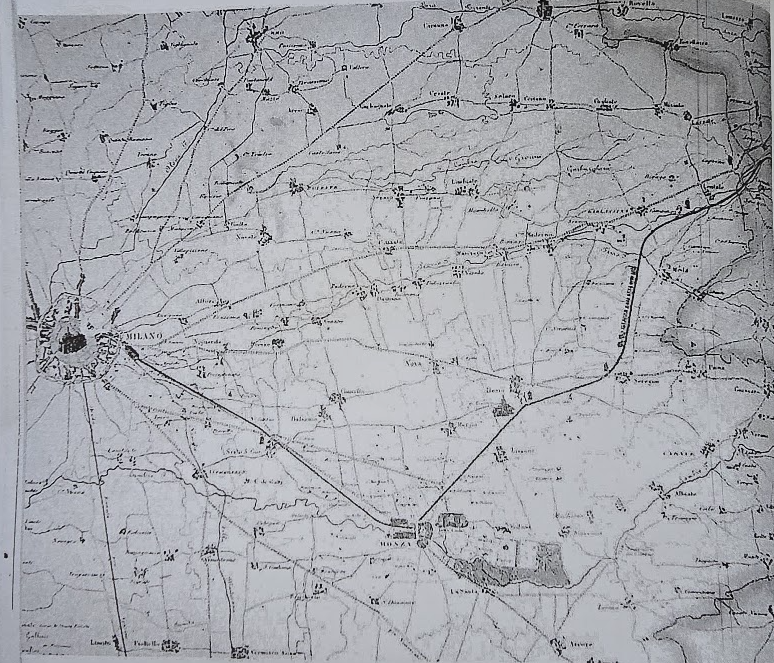
Map of the Railway from Milano to Como, 1849 ca. (Civica Raccolta Stampe Bertarelli, Milano).
In 1885, in books that recall the historical events of that year, it is written: Brianza is pervaded by strikes and great peasant agitation that even involve Lissone, the most socially compact centre around the church, already strongly characterised by craftsmanship. In the subsequent administrative elections, what Renato Zangheri writes in "Agriculture and peasants in the history of Italy" is reported: "In Lissone this time too the ballots were all written by agents, stewards, bailiffs, etc. and contained the names of the usual privileged ones. But the people of Lissone knew how to remove one to put one of their own on whom they had agreed".
The "even Lissone" reveals the surprise in the writings of historians of the 1970s, as they considered the people of Lissone of that period, due to their strong bond with the clergy, as "bigoted strike-breakers". A normal knowledge of the events that mark the history of Lissone would have revealed to them that the interweaving that bound the population of Lissone and the clergy was not just religious. Its commitment was directed towards social issues, helping those in need, but above all educating the population, making them aware that alongside duties there were also their rights that they had to defend. This is already evident with the events of 1613, but is evident with what happens in the early years of the 20th century.
In 1901, in the Catholic sphere, action was taken creating the prerequisites to found the Catholic Labour League which defends workers' rights and was already operating when its statute, on 13th June 1905, obtained the approval of the Cardinal of Milan. In 1908, within it, the cooperative of carpenter craftsmen was born for the purchase of timber and sale of furniture. In 1909 it had about 350 members.
In the same decade, the labour chamber of Monza attempted to create its own section in Lissone for a secular alternative, both in 1902 and during and after the strikes of turners in 1907 and marble workers in 1911, which lasted more than two months. However, it managed to gather only a few memberships which decreased in the following years, not allowing a section to remain open. All this led to the conclusion that the Catholic Labour League offered more opportunities and assistance.
The importance of Lissone in the wood sector is verified by data from the book "The furniture industry in Brianza" of September 1904. The data on railway movement at Lissone station from 1st January to 15th December 1901 show:
Calculating that annual working days are 300, one realises the enormous daily work that gravitates around Lissone station. On the same page it is written that in April 1903, 14,501 kg of furniture departed from Seregno station. Multiplying it by 12 months means that from Seregno that year 174,000 kg of furniture could have departed, or 1,740 quintals, just over 5% of the quintals of goods that departed from Lissone.
On page 26 the data collected by the labour office of the Humanitarian Society on annual Italian furniture exports are reported. In 1900 they amounted to L. 8,282,010. The municipality of Lissone alone had an annual production of L. 1,435,000, the municipality of Desio L. 12,000, the municipality of Seveso about L. 200,000. The enormous difference in production values of Lissone compared to neighbouring municipalities is evident.
This well-known Estonian plywood furniture company was founded in 1883 and by the end of the century had become the largest producer of plywood and furniture in Russia. Luterma (the A. M. Luther Mechanical Woodworking Factory) was renowned for its high-quality plywood, which was used for the production of suitcases and buckets as well as furniture. The company's early types of furniture included office and railway furniture as well as domestic designs.
In 1908 Luterma established a sister company in London, the Venesta Plywood Company (the name Venesta deriving from Veneer and Estonia), its international perspective being supported by the establishment of branches in many European countries including Germany, Sweden, France and Italy. By 1914 much of its production reflected direct functionalism although there were occasional examples of surprising innovation such as in the sculptural and fluid forms of a 1908 screen (Model no. 1138) that anticipated developments in Finland by Alvar Aalto and Artek.
With the closure of Russian markets after the First World War, Luterma had an important economic and social role in furniture production, a significant amount of which was oriented towards utilitarian and everyday types. Before the First World War Luterma boasted one of the largest furniture departments in the Baltic countries, producing folding chairs and tables for the British market along with domestic, public and office furniture for the Baltic markets.
With the considerable expansion and industrialisation of Tallinn there arose the need to produce a new range of furniture that was suitable for the rapid growth in the supply of rationally planned apartments and housing designed to meet the expanding working class. Luterma had begun to develop its interest in this sector by organising a competition in 1919 for well-designed and economical wooden furniture for small apartments. Along with such initiatives Luterma converted its Tallinn warehouse into a modern showroom for a wide display of domestic and office furniture.
In the mid-1930s the company promoted a "Furniture for All" initiative supported by the Ministry of Economy, producing flexible modern designs using standardised forms with interchangeable modular units that could be combined in different ways. Such designs embraced the principles of Modernism and empathy with the design aesthetic of existenzminimum ("living in minimal space") that had been explored elsewhere in avant-garde circles in Europe - in Vienna, Warsaw, Frankfurt, Stuttgart and other cities involved in progressive large-scale housing programmes.
In Britain, Jack Pritchard who worked for the Venesta Plywood Company, Luterma's sister company, was involved with architect Wells Coates in the design of the "minimum apartments" at Lawn Road, Hampstead (1932), and in the Isokon plywood furniture designed by Walter Gropius and Marcel Breuer. Luterma's equally adventurous, but less publicised, policy continued until 1940 when Estonia was annexed by the Soviet Union.
N.B. Consolidating with De Capitani, in Lissone it acquires new knowledge on the design and construction of furniture for that increasingly numerous part of the European population that in those years had reached a certain well-being.
Its furniture production sector changes from secondary to primary. Lissone from this collaboration becomes the most important Italian centre first for plywood and then for the processing and production of composite materials.
Leading industries in the national and European field would arise in 1920, Incisa, which among other things in the 1950s would create Novopan which is the forerunner of OSB now used on a planetary scale, Alecta in the early 1930s, Simplex which using new glues in the 1950s creates products with technological qualities superior to products made of ferrous material.
At the end of the 19th and beginning of the 20th century, Lissone's reputation crossed national borders: the participation of Lissone companies in fairs and exhibitions in Europe and the United States did not go unnoticed, as evidenced by the various awards obtained by the furniture presented.
An important part of Lissone furniture training is certainly attributable to education that forms highly qualified workers. The school of drawing and carving and teachers repeatedly receive commendation from the authorities and obtain the right recognition in 1906 during the International Exhibition of Milan, organised on the occasion of the inauguration of the Simplon Pass. The evening school of drawing and carving and the Lissone native Dassi Ignazio were awarded with diploma and medal.
Production was not only aimed at the needs of the individual buyer: with a vision that for that period was certainly innovative, furnishing requests from large hotels with more than 100 rooms were fulfilled.
The supply request is divided by individual item, which is given to a workshop for production; there are therefore dozens of workshops working to satisfy the commission. There are those who make beds, those who make bedside tables, those who make chests of drawers, those who make wardrobes, those who make mirrors, those who make armchairs, etc. In doing so, specialised workshops are created that over time increase their experience by improving the product.
It is in this context that Luterma, among the largest sawmills in Europe producing tables and chairs in Tallinn, Estonia, between 1907 and 1908, to increase its sales market in Europe, opened branches in various European capitals. In Italy it chose Lissone, partnering with De Capitani.
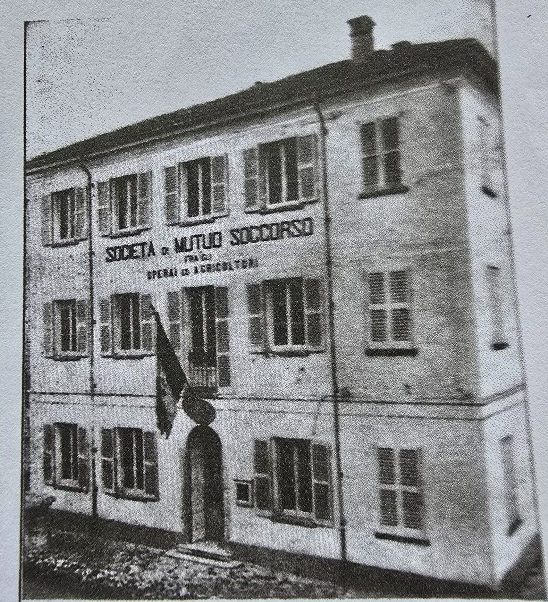
Old building for the Society and the school of drawing and carving, 1898.
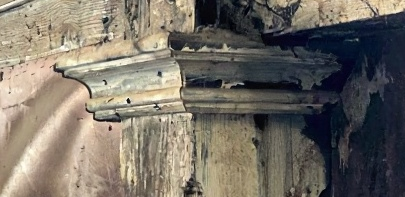
The capital in a portico of one of Luterma's production sites in Via Magenta 10, Lissone is the only testimony of Luterma in Lissone. Never mentioned in documents in the Fascist era, whilst in books and theses of the 1970s and following the name, the city of its headquarters and the nation are often wrong.